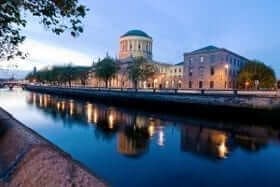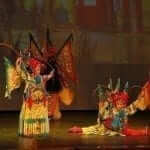
Our Visit to the Book Of Kells
As part of our preparation for Seachtain the Gaeilge and all things Irish we decided to visit Trinity College to view the Book of Kells. It’s always important to reflect on our culture and language to better understand how we communicate today.
Trinity College is a place steeped in history so studying there must be a great opportunity for students. The fantastic gates of Trinity College open up another world to you inside. After passing under the entry and crossing the alley, a large paved stone court welcomes visitors. In the middle an arch rises up and by its right side sits the Sir Lecker statue. He is anecdotally decorated with a pair of wool-pompom shoes. Obviously a joke by one of the students coming and going within the multiple buildings composing Trinity College.
Following the instructions given by the shop you can easily find your way and arrive at the entrance of the prestigious Trinity College Library. This is one of the most important research libraries in the world. The Book of Kells, the oldest book in Ireland is kept there.
It’s a few weeks to go before celebrating Seachtain na Gaeilge, the Irish Language Week (5th to 17th March), so we took the opportunity to discover a monument of Irish culture.
You can see the Book of Kells on display in the library at Trinity College. It is a lavishly decorated book of manuscripts written in Latin of the four gospels of the life of Christ. The book has long been associated with Saint Columcille (c 521 – 597 AD) from Donegal, and was probably produced early in the 9th century by the monks of Iona located at the western coast of Scotland. For security, the book was sent to Dublin circa 1653. It arrived to Trinity College through the agency of Henry Jones (bishop of Clogher). It was not intended for daily reading, but rather to decorate an alter for special occasions.
The Book is written on vellum (calfskin), so the presence of hair follicles has been found on some leaves. In its original state it has been calculated that the book used the skins of about 185 calves. We can see on a picture that some leaves have been spoiled with sizeable holes. In spite of its age, the book is really well preserved with little damage. The details of the images and the meticulousness of the realisation is stunning. Four books were shown to the visitors in the East Pavilion…
- The Book of Kells (two gospels are exhibited)
- The Book of Armagh
- The Book of Durrow
The main chamber of the Old Library is called the Long Room. It houses around 200,000 of the Library’s oldest books. Running through the aisle, on both sides, lies a collection of marble busts that have been commissioned from several sculptors. The harp is the oldest to survive from Ireland and probably dates from the 15th century. It became an emblem of the early bardic society, and thus appears on Irish coins.
At STAR Translation Services, we are aware of the importance of history and culture. We help to promote the Irish culture through our services by translating your documents professionally into Irish, we contribute to the communication of the Irish language and Irish culture.

